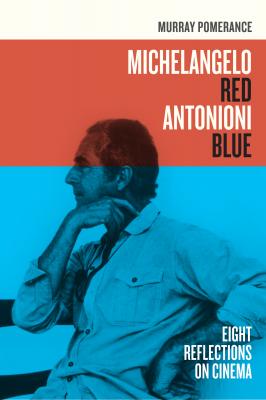Michelangelo Red Antonioni Blue. Murray Pomerance
Читать онлайн.| Название | Michelangelo Red Antonioni Blue |
|---|---|
| Автор произведения | Murray Pomerance |
| Жанр | Кинематограф, театр |
| Серия | |
| Издательство | Кинематограф, театр |
| Год выпуска | 0 |
| isbn | 9780520948303 |
Aix—old Aix, at least—is a city of sandstone buildings, tiny streets, and a thousand fountains, with the grand, confrontational Mont Sainte-Victoire on its eastern edge among modest, shady groves of pine. It is a place—at least the Aix that Antonioni photographs in Beyond the Clouds is a place—that offers itself to the spirit of the wanderer without making any imposition. As we follow Niccolo and the girl, as we listen to them address one another in an extended dolly that moves down blocks and turns corners and crosses little squares, we have no anticipation of arriving at a summary destination but only, with each of their steps, contentment at the experience of penetrating and then relinquishing a space. Satisfaction is beyond consideration. “Are you satisfied, madame?” the young man asks a middle-aged woman who is passing by, and she smiles indulgently at the ridiculousness of the question; yet we see that she is entirely pleased with her condition, even though it is not a condition of satisfaction. She is hardly bored, or irritated, or even displaced by her lack of satisfaction. Aix removes the question of satisfaction from the equation.
To experience art is an act of faith. To make art, to paint a canvas, is innocent, an abandonment while also a consumption of the self. Everything is the subject, its distance, its roundness, proportion, history, implication, its weight—which is to say, in Cézanne, its lack of weight, its light. (Color is light, and that is why color is everywhere.) But to look at a painting is an affirmation of the self, because in this act we struggle to believe in the existence of the qualities we admire. We elevate art, but not without the expenditure of effort that also produces an elevation of the self. To see the world clearly, as Cézanne saw it, is to diminish the self to a point, but in order to admire someone else’s vision of the world one lifts it onto one’s shoulders. One is working, after all, to convince oneself that this is an Original—special, worthy of considered attention—but then suddenly, as though on the opening of a door into a grand arena, one sees or hears all of it with a new and surprising clarity, and it is all present and accounted for, effortless, pristine, full, in a flash, and then originality disappears as a consideration, becomes trivial in the face of what the work actually is. Yet is this vision or this audition not something like what occurred for and to the artist at work? For an instant we have the opportunity to share that vision or audition by performing it again, by repeating history. (In the brief interlude directed by Wenders, when Mastroianni painting the Mont Sainte-Victoire is interrupted by Moreau stepping up to converse with him, this is what he tells her, too: that the meaning for him in copying the original Cézanne resides in trying to experience what the painter experienced, and this is not copying.) The artist, it is certain, labors with the conviction that such an audition, such a perception, is possible, surely for the artist who regards the world but also for those who come to the work of art. He shows or perhaps sings the world in such a way that others can know how he saw it, or heard it open itself and sing to him, through the obstruction of daily life—and not just obstruction but continual obstruction and darkness, that rent to be paid, the paint dry upon the palette, the bon mot slipping away into those moist blue recesses of the absurd and the undiscovered. Or the opinions of the strangers standing next to one’s elbow, always too informed. The world must finally vibrate so that it rises off the map: Mont Sainte-Victoire ceases to be that stalwart lump at 43° 32' N, 05° 39' E and becomes an ineffable presence. If one listens carefully to a choir in a church, if one gives oneself entirely to each voice and the combination of voices, one can also hear the stones from which the vibrations of these voices are recoiling. It is the stones, as much as the music, that have the power to put one to sleep, since by way of those who sing the stones themselves have voice, just as by way of the painter the mountain speaks or as by way of the filmmaker the space of the urban intérieur (which Walter Benjamin described, “furnished and familiar” [Gunning 106]), its cherished objects or its lack of things, its paintings even standing upon the floor, its plate glass partitions, is permitted to enunciate the world.
Voices
It is rather evident to the eye, even disturbingly so as we watch, that as they walk through the city, the girl almost never looks at the young man. Speaking through the voice of an off-camera narrator in To Make a Film Is to Be Alive, a documentary about the making of Beyond the Clouds that is published on the DVD, Antonioni explicitly draws attention to the fact. She needs, says this narrator, “no reassurance from him. Security is not what she needs. A serenity verging on indifference seems to pervade her.” This is surely difficult, if only because serenity is sacred while indifference is mundane. The girl is unruffled, but she is also a little stiff, as though the force of attraction exercised by his hungry ministrations and gaze has made her capable of falling from a kind of pedestal that is gliding
